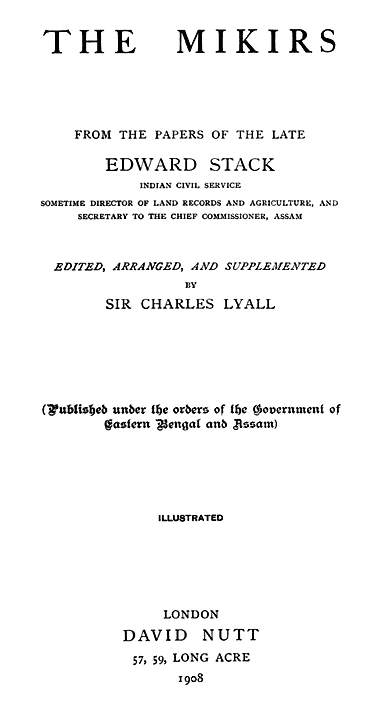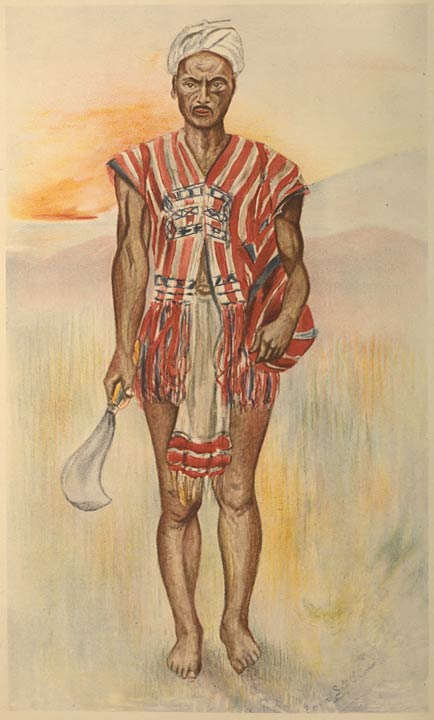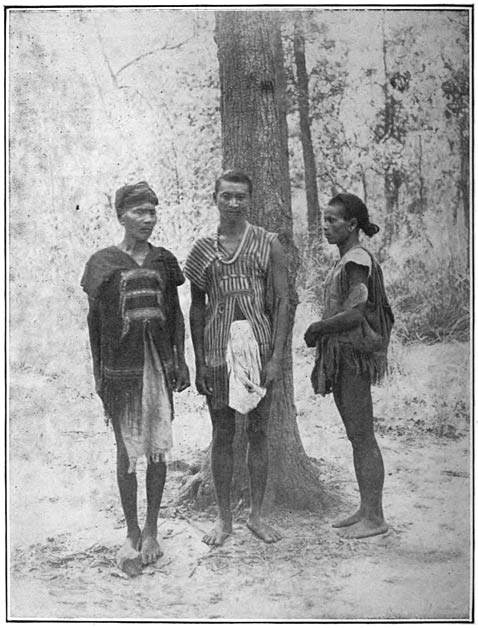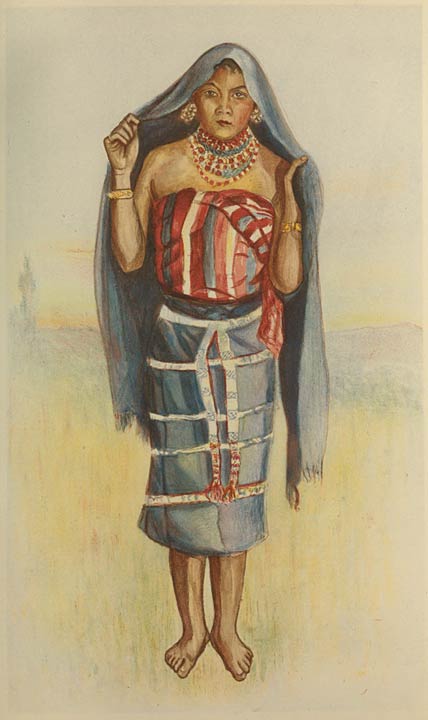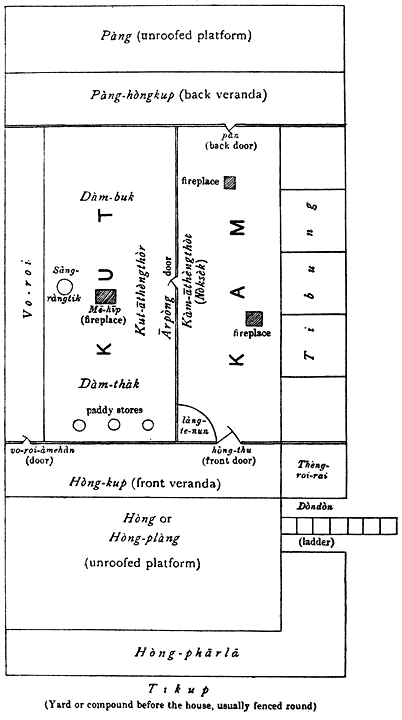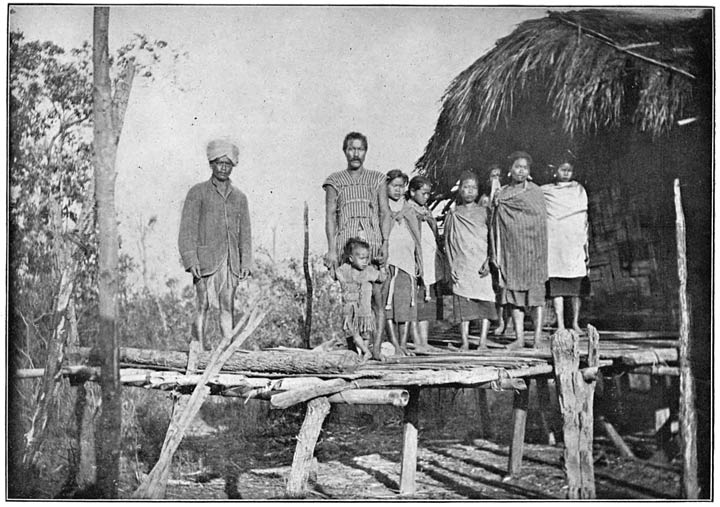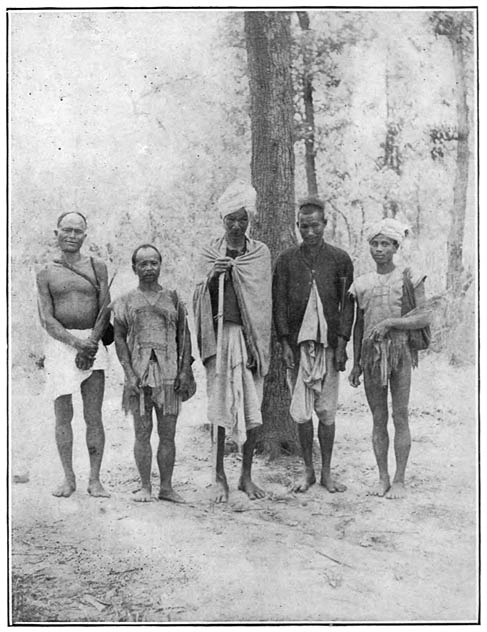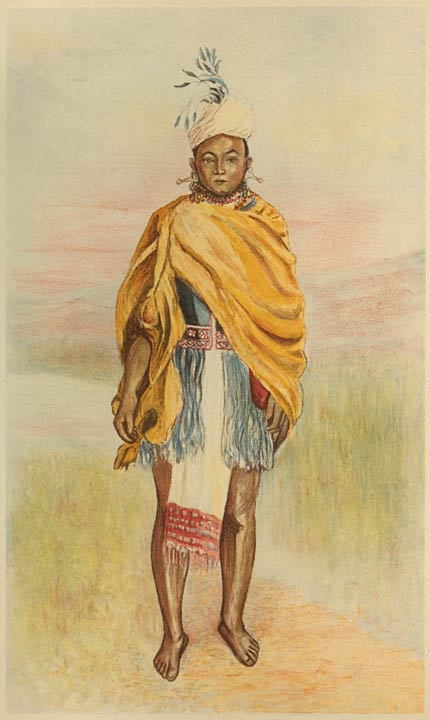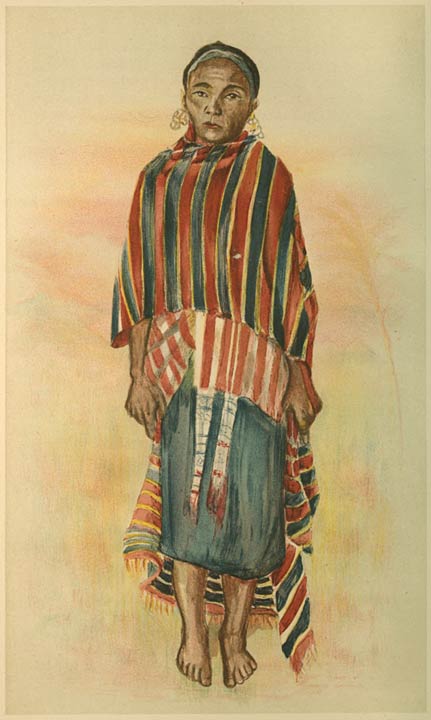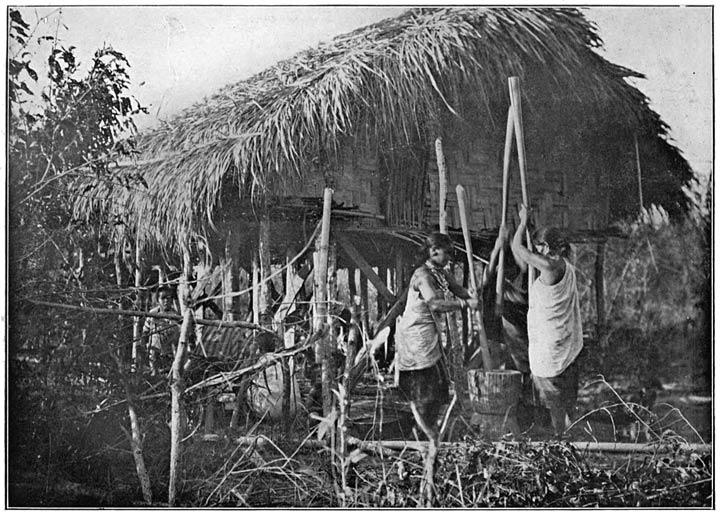Some idea of the mental equipment of the Arlengs
will have been gathered from the two preceding sections. It has been
seen that, within the limited circle of their experience, they possess
a medium of expression which may be described as adequate to their
needs, well knit together in its mechanism, and copious in concrete
terms, though, like all such languages, wanting in the abstract and
general. Their folk-tales are lively and effective as narratives, and
the themes, though probably borrowed from the great treasury of popular
story elaborated in Peninsular India, have been appropriated and
assimilated to the social conditions of the Mikirs themselves. Little
has hitherto been done to enlarge the resources of the language in the
direction of higher culture, or to use it for the expression of ideas
lying beyond the scope of the tribal life; but there appears to be no
reason to doubt that the language of the Mikirs will be found in the
course of time to be as capable of development for this purpose as the
speech of their neighbours the Khasis.1
The leading feature of the race, in contrast with other
hill tribes of Assam, is its essentially unwarlike and pacific
character. Its neighbours—Khasis, Kachāris, Kukis,
Nagas—have for centuries been engaged in continuous internecine
strife, and their tribal individualities have been preserved, and
differences accentuated, by the state of hostility in which each unit,
however small, lived with all adjacent peoples. The Mikirs [152]have
always, at least during the last two centuries, been, as Major Stewart
described them in 1855, “good subjects.” Numbering some
ninety thousand souls, they are extremely homogeneous, while other
tribes in their neighbourhood differ in an extraordinary manner from
village to village, and constantly tend to split up into smaller
aggregates, looking on all outsiders as enemies. No such disintegrating
influence has affected the Arlengs. Whether in North Cachar, the
Jaintia Hills, Nowgong, or the Mikir Hills, their tribal institutions,
their language, and their national character are identical, and they
pursue their peaceful husbandry in the same manner as their
forefathers, raising in ordinary years sufficient food for their
subsistence, and a considerable amount of cotton and lac for export to
the plains. In these circumstances, surrounded by warring tribes, and
still nomadic in their habits of cultivation, they have from time to
time found it necessary to place themselves under the protection of
stronger peoples. It has been mentioned in Section
I. that the traditions of the race show that they were formerly
subject to the Khasi chiefs of Jaintia and the eastern states of the
Khasi Hills, and that they migrated thence to the territory subject to
the Ahom kings.2 During their sojourn in Khasi-land they
assimilated much; dress (p. 5), ornaments (p. 6), personal names (p.
17), methods of divination (pp. 34, 35), funeral ceremonies (pp.
38–42), memorial stones (p. 42), all come from the Khasis, who
have also contributed many words to their common speech. Borrowings
from Hinduism are equally manifest in their language, their folk-tales,
and their religion. Assamese words are numerous in Mikir; Ārnàm Kethē (p. 30) seems to be a
translation of Mahādēva;
Jòm-āròng (p. 28), and the ideas linked
therewith of an after-life, are strongly impressed with a Hindu
stamp.
Yet they retain, together with these borrowed features,
a sufficiently definite stock of original characteristics. Physically
they differ much from Khasi and Assamese alike. Their social fabric is
based upon clearly marked exogamous groups, with patriarchal principles
of marriage and inheritance; they call these by a Khasi name
(kur), but have no trace of the matriarchal [153]family as known among the Khasis. They build
their houses on posts, while their neighbours, except the Kukis, build
on the ground. Their deities are of the primitive kind which is common
to all Indo-Chinese races, well known, under the name of Nats,
as the object of popular worship and propitiation in Burma.
Ever since the race has been studied, it has been
noticed that it was difficult to establish its exact place and
affinities in the heterogeneous congeries of peoples who inhabit the
mountainous region between India and Burma. This was remarked by
Robinson in 1841 and 1849, by Stewart in 1855, by Damant in 1879. At
the Census of 1881 an attempt was made to bring the Mikirs into
relation with the Boro or Kachārī stock; but it was seen at
the time that more must be ascertained regarding their neighbours
before any final judgment could be arrived at. Dr. Grierson, on
linguistic grounds, has classed them in the Linguistic Survey as
intermediate between the Boro and the Western Nagas. It appears to the
present writer, in the light of the much fuller information now
available, that they should be classed rather with those tribes which
form the connecting link between the Nagas and the Kuki-Chins, and that
the preponderance of their affinities lies with the latter of these two
races, especially those dwelling in the south of the Arakan Roma range,
where the Chin tends to merge into the Burman of the Irawadi
Valley.
When Robinson and Stewart wrote, it was still remembered
that the Mikirs had once been settled in strength in the country (now
called North Cachar) to the immediate north of the Barāil Range,
and in contact with the Angāmi, the Kachcha, and the Kabui Nagas;
and that, exposed as they were in this locality to the inroads of the
Angāmis and the oppression of the Kachāri kings, they had
migrated westwards to the territory of the Jaintia Raja in search of
protection. It was noticed in the Assam Census Report of 1881 that in
this region north of the Barāil, where there are now no Mikirs,
local names belonging to their language indicated their former
presence. When they lived there, they must have been in touch with
tribes belonging to the Kuki-Chin stock, who have for centuries
occupied the hill ranges to the south of the valley of Cachar, and the
mountains between that valley and Manipur. [154]
The institutions of co-operative agriculture by the
village lads (p. 11), the bachelors’ house or
teràng (id.), the former custom of ante-nuptial
promiscuity (p. 19), and the traces of village tabu resembling
the Naga genna, still characterizing the annual festival of the
Ròngkēr (p. 43), all point to a connection with the
Western Naga tribes, rather than to affinity with the Kachāri
stock. From the Kuki and Chin tribes the Mikirs are distinguished
chiefly by their pacific habits, and by the absence of the dependence
upon hereditary tribal chiefs which is so strong a feature among the
former. The customs of both races as regards the building of houses
upon posts, with a hong or open platform in front, are
identical; in Major G. E. Fryer’s paper “On the Khyeng
people of the Sandoway District, Arakan,” published in the
Journal of the Asiatic Society of Bengal for 1875 (pp. 39, 99),
a Khyeng house is figured which bears a striking resemblance to the
Mikir house. The institutions of domestic and individual life among the
Khyengs (Chins), as described by Major Fryer, especially as regards
marriage, funeral ceremonies, the disposal of the dead (after copious
feasting of friends and relatives) by cremation, the rules of
inheritance (females being wholly excluded from succession), the
treatment of disease, the propitiation of spirits, and the annual
festivals in honour of the gods who preside over man’s welfare,
present the closest analogy to those of the Mikirs as set forth in this
monograph. Like the Mikirs, the Chins are divided into exogamous groups
and follow the rule of male kinship; but, like the Mikirs also in this,
the approved marriage is that between a man and his first cousin on the
mother’s side. It has been noticed already (p. 21) that the word
for father-in-law (òng-hai,
wife’s father) in Mikir is identical with that for maternal
uncle, òng, and that son-in-law,
osā, also means nephew (sister’s
son). The story of “the Orphan and his Maternal Uncles”
illustrates the obligation which lies on a lad to marry his
mother’s brother’s daughter (see above, p. 53). Similarly,
Harata Kuṅwar, though but a mortal, calls his father-in-law the
Bārī-thē Rēchō ònghai
(p. 147), and is spoken of by him as osā (id.),
while the fairy princesses call him cousin, kòrpō (p. 127). The same phenomenon appears in
the Kuki-Chin languages. In Shö or Chin [155](Khyeng) apū means both maternal
uncle and father-in-law; so also in Lushei, pu has both
meanings. The following list of words indicating relationship in Mikir
and Lushei (representing the Central Kuki-Chins) shows how closely the
two languages correspond in this important part of their
vocabulary:—
|
Mikir. |
Lushei. |
| grandfather |
phu |
pu |
| grandmother |
phi |
pi |
| grandson |
su-po |
tu-pa |
| granddaughter |
su-pī |
tu-nu |
| father |
pō |
pā |
| mother |
pei |
nu |
| aunt: |
|
|
|
father’s sister |
nī |
ni |
|
mother’s sister |
pi-nu |
nu |
|
father’s brother’s wife |
nī |
nu |
Among all these tribes the most important index to
racial connexion is to be found in their languages. No one would now
assert that language, any more than religion, is everywhere a
conclusive mark of racial unity; immense masses of the people of India
to-day speak languages imposed upon them from without, and Aryan speech
has extended itself over many millions in whose blood nothing is due to
the original invaders from the north-west. Again, the practices of a
predatory state of society bring into the tribe slaves and wives from
outside; or, as among the Mikirs (p. 33), aliens may be accepted on
equal terms as members, thus modifying the unity of blood. On the other
hand, it would be equally unreasonable and opposed to the facts to deny
that, among such communities as the Tibeto-Burman peoples of Assam,
race and language do, constantly and in a general manner, coincide.
People who speak a tongue which is unintelligible to their neighbours
are necessarily thrown together into a unity of their own. Their
ancestral ideas and institutions, secular and religious, their tribal
history, must tend to keep them united, and perpetuate the influence of
a common origin by the fact that all outside the community are actual
or potential enemies. Language, therefore, when it coincides with
tribal separateness, is our chief guide in determining the relationship
of the hill tribes of Assam one to another.
Here another qualification is, however, necessary. The
word-stock of the Tibeto-Burman races is to a large extent [156]identical. The same methods of arranging the
elements of the sentence, in other words the same general principles of
grammar, prevail throughout the whole family of speech. We must,
therefore, in investigating the nearer kinship of one group to another,
not be misled by linguistic resemblances which are common to the whole
stock to which both groups belong.
In comparing Tibeto-Burman languages it has been usual
to choose for examination in the first place the numerals and in the
second the pronouns. The vocabulary of nouns, adjectives, and verbs is
liable to disturbing influences which do not equally affect the simple
ideas represented by number and person. Let us begin, therefore, with
the numerals. These, so far as they are necessary for our purpose, are
as follows in Mikir:—
| one, |
īsī |
| two, |
hīnī |
| three, |
kethòm |
| four, |
philī |
| five, |
phòngō |
| six, |
theròk |
| seven, |
theròk-sī |
| eight, |
nēr-kèp |
| nine, |
sir-kèp |
| ten, |
kèp |
| eleven, |
krē-īsī |
| twelve, |
krē-hīnī |
| thirteen, |
krē-kethòm |
| etc. |
|
| a score, |
ing-koi |
| twenty-one, |
ing-koi-rā-īsī |
| etc. |
|
| thirty, |
thòm-kèp |
| forty, |
philī-kèp |
| etc. |
|
| a hundred, |
phārō |
Here the first thing to be noticed is that the three
numerals between six and ten are not independent vocables, but
compounds; seven is six plus one: eight is ten minus two,
and nine is ten minus one. In most of the other languages of the
family this is not so; the Boṛo, the Naga, and the majority of
the Kuki-Chin languages all have independent words for seven, eight,
and nine. It appears to be only in the Kuki-Chin group that we can find
an analogy to the Mikir words for these three numerals. In Anāl, a
language of the Old Kuki family spoken in Manipur, seven is
tak-si which seems to be identical with the Mikir
theròk-sī; and in Meithei (the language of the
Manipuris) eight is ni-pān,“two from ten,” and
nine is ma-pān, “one from ten.”
We next notice that ten is expressed by two
separate words, kèp (in ten and its multiples)
and krē (in the compounds from eleven to
nineteen). So far as vocabularies have yet been [157]published, the only other tribes of the
Tibeto-Burman family3 which have a word resembling
kèp for ten are Maring Naga, one of the Naga-Kuki
languages, where it is chip, and Shö or southern Chin,
where gip is used for ten in the sequence thirty, forty, fifty,
etc. (thum-gip, thirty, mlī-gip, forty,
nghā-gip, fifty, exactly corresponding to the Mikir
thòm-kèp, philī-kèp,
phòngō-kèp). The close resemblance of the
other numerals in Maring to Mikir forms is noticeable; four is
filī, five fungā, and six tharuk. The
other word for ten, krē, strongly resembles the Angāmi
kerr or kerru and the Kachcha Naga
gārēo; in the Central Naga group the prefix ke-
has been replaced by ta- or te-, and the words for ten
are ter, tarā (Ao), tarō,
tarā, tarē (Lhota), etc. In the Naga-Kuki group
Sopvoma has chirō, Marām kero, Tangkhul
tharā, etc. In the Kuki-Chin group Meithei tarā
is the same word: in the Central Chin another prefix, pu-,
pö-, or pā-, is used, and we have Lai
pörā, Banjogi parā, Taungthā
parhā. There are no Boṛo forms which correspond to
krē, nor any much resembling kèp.
The Mikir word for twenty, ingkoi, is made up of
the prefix ing-, and koi, formerly (before the loss of
the final l) kol. Kachcha Naga has the same word,
engkai, Kabui choi, koi, or kol. The word
also appears in Garo (kol), Tipura (khol), and
Deori-Chutiya (kwa), of the Boṛo group; Angāmi
me-kwū, me-khi, mekko, Lhota
me-kwī, mekwü, in the West and Central Naga
groups; Marām and Sopvoma (makē, makei),
Tangkhul (magā), Phadeng (ma-kui), in the Naga-Kuki
group, and Singpho khun. In the Kuki-Chin languages it is very
common (Meithei kul, Siyin kul, Lai pö-kul,
Shonshē ma-kul, Banjogi kūl, Shö [Chin]
kūl, goi). There does not appear to be any trace of
this word for a score in the Tibetan and Himalayan languages, where
twenty is invariably rendered by “two-tens.”4 The Northern Indian word
kōṛī, which has the same meaning, has been
compared with it; it is difficult, however, to imagine borrowing on one
part or the other.
In the series of tens, 30 to 90, Mikir prefixes the
multiplier: thòm-kèp,
philī-kèp, phòngō-kèp,
etc. The Boṛo group prefixes [158]the tens (Garo
sot-brī, 40, sot-bonggā, 50, sot-dok,
60, etc.).5 The Naga group has both systems; Angāmi
prefixes the tens: lhī6-dā, 40,
lhī-pangu, 50, lhī-suru, 60; Lhota and Ao
suffix them: Lhota tham-dro, 30, zü-ro, 40,
rok-ro, 60; Ao semur’ 30, lir’ 40,
rok-ur’ 60. In the Kuki-Chin group the majority of
dialects prefix the tens (Thado and Lushei sōm-thūm
30, sōm-lī 40, etc.), and this is also the rule for
Kachcha Naga, Kabui, and Khoirāo, as well as for all the languages
classed by Dr. Grierson as Naga-Kuki. But the Shö or southern
Chins not only have the same collocation as the Mikirs
(thum-gip, mlī-gip, nghā-gip)—an
arrangement which also obtains in Burmese,—but use the same
words. This coincidence is very striking.
The word for a hundred, phārō, bears no
resemblance to any word expressing this numeral in the Boṛo
languages. It agrees with the Angāmi krā,
Kezhāmā krī, Sopvoma krē, and in a
remarkable way with the words used by the Southern Chins (Taungthā
ta-yā = tarā, Chinbòk phyā =
phrā, Yawdwin prā, Shö (Chin)
krāt). It will be seen that phā- in Mikir,
k- in the Naga languages, and ta-, ph-, p-
and k- in the Chin dialects, are numeral prefixes, and that the
essential element of the numeral is rā (Mikir
rō) or rāt. It appears in this form, without
any prefix, in several other Kuki-Chin languages.
Here should be mentioned a custom which obtains in Mikir
of counting by fours; a group of four is chekē or
chikē, which corresponds to the Boṛo zakhai
(jakhai). This system is used for counting such things as eggs,
betel-nuts, fowls, etc., of the same class; e.g. vo-tī
chikē phòngō-rā ē-pum, 21 eggs (4
× 5 + 1): chikē phòngō-rā
pum-thòm, 23 eggs (4 × 5 + 3). Possibly one language
has borrowed from the other. (This method of counting by fours is
common throughout the Aryan languages of Northern India, where a group
of four is called (gaṇḍā.)
Our conclusion from these comparisons is that while
Mikir has few coincidences, beyond those common to the whole
Tibeto-Burman family, with the Boṛo group, it has many with
[159]the Naga and Kuki-Chin groups, and especially
with the Shö or southernmost Chins.
Before leaving the numerals, something must be said of
the prefixes which they exhibit throughout the Tibeto-Burman family.
Taking first that member for which we have the oldest materials,
Tibetan, the first ten numerals are as follows:—
|
As written. |
As now spoken
in Central Tibet. |
| one |
gchig |
chik |
| two |
gnyis |
nyī |
| three |
gsum |
sum |
| four |
bzhi |
shi |
| five |
lngā |
ngā |
| six |
drug |
ḍhuk |
| seven |
bdun |
dün |
| eight |
brgyad |
gyā |
| nine |
dgu |
gu |
| ten |
bchu |
chu |
Here we observe several different prefixes, once no
doubt supplied with vowels, but from the dawn of written record united
in Tibetan with the following consonant, and now no longer heard in
utterance; in the first three units the prefix is g-: in four,
seven, eight, and ten it is b-: in six and nine it is d-:
and in five it is l-.
In the Tibeto-Burman languages of Assam and Burma we
find the same phenomenon of numeral prefixes; but while some languages
have the same prefix throughout the ten units, others, like Tibetan,
have several different prefixes. In some cases, again, the prefixes
have been incorporated in the numeral and are no longer recognized as
separable, while in others they may be dropped when the numeral occurs
in composition; in others, again, the prefixes have (as in spoken
Tibetan) been dropped altogether.
Of the first class the best examples are the Central
Kuki-Chin languages:—
|
Lai. |
Shonshē. |
Lushei. |
| one |
pö-kat |
ma-kat |
pa-khat |
| two |
pö-ni |
ma-nhi |
pa-nhih |
| three |
pö-thūm |
ma-ton |
pa-thum |
| four |
pö-lī |
ma-li |
pa-lī |
| five |
pö-nga |
ma-ngā |
pa-ngā |
| six |
pö-ruk |
ma-rūk |
pa-ruk |
| seven |
pö-sari |
ma-seri |
pa-sarih |
| eight |
pö-ryeth |
ma-rīt |
pa-riat |
| nine |
pö-kwa |
ma-ko |
pa-kuā |
| ten |
pö-ra |
ma-rā |
shom |
[160]
Of the second class Mikir, in common with most of the
Assam family, is an example; in one and two the prefix
ke- (representing the Tibetan g-) has been abraded to
ī- and hī-: in three it persists; in
these numbers the prefix may be dropped in composition, leaving
sī, nī, and thòm remaining. In
four and five we have the prefix phi- (for
pi-) and pho- (for po- or pa-),
representing the b- of Tibetan, but now no longer separable. In
six the prefix the- represents the original d-,
and has similarly become inseparable. In ten, the form
krē represents an original kerā, answering to
the Kuki-Chin pö-rā and ma-rā and the
Meithei ta-rā. We notice that in Mikir, as in the Naga and
Kuki-Chin languages, the hard consonants k, p, t
(ph, th) have replaced the soft g, b, and
d of the Tibetan. In the Boṛo languages, on the other
hand, the original soft consonants of Tibetan are retained, as will be
seen from the forms below:—
|
Boṛo. |
Dīmāsā. |
Garo. |
| one |
se, sŭi |
shī |
sā |
| two |
ni, nŭi |
ginī |
gnī |
| three |
thām |
gatam |
gitām |
| four |
brè, brŭi |
bri |
brī |
| five |
bā |
bongā |
bonggā |
| six |
ro, ḍo |
ḍo |
ḍok |
In these changes Mikir follows the phonetic laws
obtaining in Naga and Kuki-Chin, not those which obtain in
Boṛo.
It has been pointed out already (p. 78) that generic
determinatives are used in Mikir when numbers are joined to nouns. This
practice is common to the Boṛo languages and to the Kuki-Chin
group (as well as Burmese), but does not appear to be prevalent in the
Western Naga group. A list of the words used in Darrang
Kachārī is given at p. 13 of Mr. Endle’s grammar; for
Garo, a list will be found at p. 6 of Mr. Phillips’s grammar; it
much resembles the Darrang list, but neither contains any forms
coinciding with those of Mikir except the Garo pat, used for
leaves and other flat things, which resembles the Mikir
pàk. On the other hand, in Kuki-Chin we have in Lai
pum for globular things,7 the same as in Mikir, and
in Shö (Chin) we have for persons pün, the Mikir
bàng (bàng in Mikir and pang in
Lushei mean body), and for animals zün, the Mikir
jòn (Mr. Houghton’s grammar, p. 20). Here again the
affinity of the Arleng is with the Kuki-Chin group, [161]and
especially with its southernmost member, rather than with the
Boṛo.
Turning now to the pronouns, the Mikir nē
for the first person singular finds it exact equivalent only in the two
Old Kuki dialects Anāl and Hirōi, spoken in Manipur, where
the corresponding pronoun is ni (Anāl) and nai
(Hirōi). In Boṛo the form is āng, in Angāmi
ā, in Sema ngi, in Ao nī, in Lhota
ā, in Kachcha Naga ānui. In the majority of the
Kuki-Chin family another stem, kei or kē, is used.
Here Mikir agrees with the two Kuki dialects mentioned and with some of
the Naga forms, rather than with Boṛo.
For the second person singular all the Tibeto-Burman
languages of Assam have nàng, or closely similar
forms.
For the third person Mikir now uses the demonstrative
lā, but, as the possessive prefix shows, had formerly
ā. In this it agrees with Lai, Lushei, Chiru, Kolren among
the Kuki family, and Tangkhul and Maring among the Naga-Kuki group.
What the original Boṛo pronoun of the third person was is not now
ascertainable; the demonstrative bi (Darrang), bē
(Lalung), bō (Dīmāsā) or uā
(Garo) is now used instead. This seems to correspond with the Mikir
pe-, pi-, pā- in the words mentioned on p.
80. In Angāmi the pronoun is similarly pō, in Sema
pā, and in Ao pā. In Meithei and many other
Kuki-Chin languages another demonstrative, ma, is used; this may
be connected with the Mikir mi, me, in minī,
to-day, menàp, to-morrow (see p. 80). But, although
ma is used as a separate pronoun for the third person in the
majority of the Kuki-Chin group, the prefixed ā- of
relation, usual in Mikir, which (as explained on p. 76) is really the
possessive pronoun of the third person, is widely employed throughout
the family, as a prefix both to nouns and adjectives, in exactly the
same way as in Mikir. This coincidence, again, is striking; the
Boṛo languages seem to present nothing similar.
The plural pronouns in Mikir are formed by adding
-tum to the singular. Exactly the same thing takes place in
Tangkhul, a Naga-Kuki language: i, I, i-thum, we;
nā, thou, nā-thum, ye; ā, he,
ā-thum, they. The plural of nouns, however, in Tangkhul is
formed by other affixes, generally words meaning “many”
(cf. the Mikir òng). [162]
Mikir has two forms for the pronoun of the first person
plural, according as the speaker includes the person addressed or
excludes him, ī-tum or ē-tum in the former and
nē-tum in the latter case. The first, it will be seen,
agrees with the general word for we in Tangkhul. In Angāmi
also two forms are used, hē-ko for we exclusive, and
ā-vo for we inclusive; the former seems to agree in
form, though not in sense, with the Mikir ē-tum. The
affinity of Mikir with the Western Naga and Naga-Kuki languages seems
to be exemplified here also. The Boṛo languages have not the
double form for this person.
The reflexive pronoun or particle in Mikir, che
(see p. 80), is represented in Thado Kuki by ki, which is
perhaps the same word. Angāmi has the, Meithei na.
Boṛo does not appear to possess any corresponding particle.
The interrogative particle -mā in Mikir (p.
80) is mo in most of the Kuki-Chin languages (in some
-em, -am), while in Angāmi it is mā, and
in Kachcha Naga mē. The same particle (mā) is
used in Garo and Boṛo for questions.
Two particles are used in Mikir as suffixes to magnify
or diminish the root-word; the augmentative is -pī (as
thèng, wood, firewood, thèngpī, a
tree; làng, water, làngpī, the great
water, the sea), the diminutive is -sō (as
hèm, a house, hèmsō, a hut;
làng-sō, a brook). Boṛo has -mā
for the augmentative, -sā for the diminutive
(dui-mā, great river, dui-sā, brook); but
Meithei and Thado have the same particles as Mikir, -pī and
-chā (ch is equivalent to s).
The Mikir suffix -pō, feminine
-pī, corresponding to the Hindī -wālā
(see several examples on p. 12 ante), seems to be identical with
the Meithei -bā (-pā) and -bī
(-pī), though it has nothing like the extensive use in
Mikir which -bā (-pā) has in Meithei.
The noteworthy separable prefix ār- in
Mikir, which is probably connected with the Tibetan prefix r-
(see ante, p. 129, note), appears to occur in the Kuki-Chin
languages, but does not seem to have any representative in the
Boṛo family. The examples in the Kuki-Chin volume of the
Linguistic Survey are found in Rangkhol (p. 6, er-ming,
“name”), Aimol (p. 215, ra-mai, “tail,”
Mikir ārmē), Kōm (p. 245, ra-mhing,
“name”; [163]ra-nai, “earth, ground”
[nai perhaps = Mikir lē in
lòng-lē]), Kyaw or Chaw (p. 254), and Hirōi (p.
282). All these forms of speech belong to the Old Kuki group, which has
already yielded several other analogies with Mikir.
The prefix ke- (ki-, kā-),
which plays so important a part in Mikir (see pp. 77, 83, 84) in the
formation of adjectives, participles, and verbal nouns, and answers to
the Boṛo ga- and the Angāmi ke-, has for the
most part disappeared from the Kuki dialects, perhaps because it
conflicts with the prefixed pronominal stem of the first person,
ka-. It survives, however, in the three Old Kuki languages,
Kōm, Anāl, and Hirōi. In Tangkhul, of the Naga-Kuki
group, it is used exactly as in Mikir, to form adjectives and verbal
nouns, e.g.:—
|
Mikir. |
Tangkhul. |
| to come |
ke-vàng |
ka-vā (to go) |
| to eat |
ke-chō |
ka-shāi |
| to remain |
ke-bòm |
ka-pam (to sit) |
| to beat |
ke-chòk |
ka-shō |
| to die |
ke-thī |
ka-thī |
The particles used in Mikir as suffixes to indicate
tenses of the verb, with the exception of that for the completed past,
tàng, which appears to be identical with the Thado and
Lushei tā, do not seem to have any close analogues in the
Kuki-Chin or Naga-Kuki groups; they are also quite different from those
used in the Boṛo group. Causative verbs, however, are in many
Kuki-Chin languages constructed with the verb pē or
pèk, “to give,” as in Mikir; and the suffix
of the conjunctive participle in Mikir, -sī, is perhaps the
same as -chū in Khoirāo. In Boṛo the prefix
fi-, answering to the Mikir pi-, was formerly used to
form causatives, as appears from verbal roots in current use; the
construction now most common uses -nu, which has the same
meaning (“to give”) as a suffix.
The negative verb in Mikir is formed by suffixing the
particle -ē to the positive root, when the latter begins
with a vowel. Similarly, in Boṛo a negative verb is formed by
adding the particle -ā. In the Kuki-Chin languages
different suffixes are employed (lo, lai, loi,
māk, ri), and in a few dialects prefixes. Here Mikir
resembles Boṛo rather than the Kuki group. But the remarkable
feature of Mikir in reduplicating initial [164]consonants before the
suffixed negative (see ante, p. 85) has no analogy in either
family, unless the isolated example in Kolren (an Old Kuki dialect)
quoted in the Linguistic Survey, vol. III., part iii., p. 19,
supplies one. It is to be observed, however, that in the construction
there cited (na-pē-pèk-māo-yai, “did not
give”), the verb pèk has suffixed to it the
negative particle māo, and that the reduplication alone
appears to have no negative force. Other examples seem necessary before
the rule of reduplication can be considered to be established. Possibly
loi and lai in Kuki correspond to the separate Mikir
negative kā-lī (see ante, p. 86).
It remains to give some examples of correspondence in
general vocabulary between Mikir and other Tibeto-Burman languages. It
has been shown above from the analysis of the numerals that prefixes
play a large part in all these languages. These prefixes, which to some
extent are interchangeable, and also differ in the different members of
the family, have to be eliminated in order to find the roots which are
to be compared. Again, certain changes in vowels and consonants between
different languages regularly occur. Our knowledge is not yet
sufficient to enable a law of interchange to be formulated; but the
following conclusions seem to be justified. In vowels, Mikir has a
preference for long ō where other languages have
-ā, especially in auslaut;8 on the
other hand long ā in Mikir is sometimes thinned down to
ē; the word rēchō, answering to the Aryan
rājā, is an example of both processes. Long
ī in Mikir often corresponds to oi and ai, as
well as to ē and ei, in the cognates. As regards
consonants, nasals at the end of syllables are often rejected; thus
within Mikir itself we have ō and òng,
dā and dàm, nē and
nèng, lā and làng. Some
languages (as for instance Angāmi9 Naga)
tolerate no consonantal endings, not even a nasal. In Mikir itself
final l has been vocalised into i or dropped; and in many
Naga and Kuki-Chin dialects (as also in Burmese) final consonants have
disappeared or have suffered great changes. As already noticed,
[165]the surd mutes k, p, t
(sometimes aspirated) have taken the place of the original sonants
g, b, d to a large extent in Mikir, though
b and d (not g) still survive in a fair proportion
of words. Boṛo generally retains the old sonants of Tibetan, and
Meithei uses both classes according to the adjacent sounds. The
palatals ch, j of Mikir tend to become sibilants,
s, ts, z, in the cognate languages; j is
also often softened to y in Kuki-Chin. L and r in
anlaut frequently interchange in Meithei, the interchange
depending on the adjacent vowels. These letters also interchange freely
in other languages of the family. In Burmese r has everywhere
been changed to y, except in Arakan. L and n also
often interchange. Initial d in Mikir seems sometimes to
correspond to l in other cognates; and it is possible that Mikir
initial s may occasionally be represented by h in the
latter, though this is not quite certain. Th and s often
interchange in anlaut, some dialects of Kuki-Chin showing the
intermediate stage of θ, which in Burmese now everywhere replaces
original s.
Lastly, it should be noticed that Tipura, an outlying
member of the Boṛo group, often exhibits a sound system more
closely corresponding to that of the Kuki-Chin languages (which are its
neighbours) than Boṛo, Dīmāsā, or Garo.
The resemblances in vocabulary between Mikir and the
Western Naga dialects are extensive, as will be seen from the list (due
to Mr. A. W. Davis) at p. 201, vol. III., part ii., of the
Linguistic Survey. These need not be repeated here. The
following is a list of Boṛo (Darrang), Dīmāsā,
Garo, and Tipura words which seem to correspond with Mikir. It will be
seen, however, by reference to the columns headed Kuki-Chin and Naga
(including Naga-Kuki), that in the case of nearly all these words the
other two families, as well as Mikir, have the same roots. They
therefore belong to the common stock of the Tibeto-Burman languages of
Assam, and do not by themselves prove any close connection of Mikir
with Boṛo. [166]
[Contents]
Nouns.
|
English. |
Mikir. |
Boṛo
family. |
Kuki-Chin. |
Naga. |
| nose |
nōkàn |
Garo, nukum, nākung |
Meithei nātōl (n) |
Tangkhul nātūng |
| Tipura, bukung |
Thado nakui |
Angāmi ā-niki |
| Lushei nhār |
E. Naga nākong, nātong |
| eye |
mèk |
Boṛo mēgan |
Meithei |
 |
mit |
Ang. mhi, mhü |
| Dīmāsā mu |
Thado |
Tangk. mik |
| Garo mik-rēn |
Lushei |
Marām mek |
|
Shö (Chin) mik |
E. Naga mik, mek |
| mouth |
ing-hō |
Boṛo khū-ga |
Lushei kā |
Ang. thā, mē-thā |
| Dīmāsā khau |
Khāmī khā |
Rengma màng-khòng |
| Garo hō-tom, ku-sik |
Shö khō |
|
| tooth |
sō |
Boṛo hā-thau |
Andro sho |
Ang. ho, hu |
| Dīmāsā id. |
Sengmai shoa |
Sema a-hu |
|
Thado |
 |
hā |
|
|
Lushei |
|
|
Shö haw |
|
| ear |
nō |
Garo nā-chil, nā-kāl |
Meithei |
 |
nā |
Ang. nü |
|
Lai |
Lhota en-nō |
|
Shö a-nhō |
Maring ka-nā |
| face |
me-hàng |
Boṛo makhàng |
Meithei māe |
|
| Garo mikkang |
Lushei hmai |
|
| Tipura mukhàng |
|
|
| belly |
pòk |
Dīmāsā ho |
Meithei puk |
Ang. vā |
| Garo ok, pī-puk |
Andro pūk |
Sema ā-pfo |
| Tipura bahak |
Shö puk |
Lhota o-pòk |
|
Lai paw |
|
|
Thado wai |
|
| father |
pō |
Boṛo |
 |
fā |
Meithei |
 |
pā |
Ang. pō |
| Dīmāsā |
Lushei |
Sema pā |
| Garo pā, bā |
Thado |
Ao ta-bā |
| Tipura bā |
Sengmai |
 |
pō |
Lhota o-pō |
|
Khami |
|
|
Shö |
|
| son |
sō-pō |
Boṛo f’sā |
Meithei |
 |
chāpā |
Lhota o-tsöe |
| Dīmāsā pasā, sā |
Thado |
Maring chā |
| Garo sā, pī-sā |
Khami chōpo |
Hatigoria chāpā |
| Tipura basā |
Shö chō |
|
| daughter |
sō-pī |
Dīmāsā pu-su |
Meithei cha-(anu)-pī |
|
|
Khami numpui-chō |
|
| cat |
mèng, mèng-kālū |
Garo mèng-gō |
Thado meng-chā |
|
| Tipura ā-mīng |
Ranghkhol meng |
|
|
Shö min |
|
| iron |
ingchin |
Boṛo shurr |
Andro sēn, sēl |
Ang. the-zhī |
| Dīmāsā shēr |
Lushei thīr |
Yachumi inchi |
| Garo sil, sar |
Thado |
 |
thī |
Thukumi īsē |
| Tipura sir |
Shö |
|
|
Khami sing |
|
[167]
[Contents]
Adjectives.
|
English. |
Mikir. |
Boṛo family. |
Kuki-Chin. |
Naga. |
| big |
kethē |
Boṛo gadet |
|
Ang. kedī |
| small |
kibī, bi-hèk |
Boṛo gahai |
Meithei ā-pīsek |
|
| bitter |
kehō |
Boṛo gakhā |
Lushei khā |
|
| Meithei khā-ba |
| Thado a-khā |
| cold |
ke-chung |
Boṛo gazang |
Lushei shik |
|
| beautiful |
mēsèn, mē |
Boṛo mozang |
Lushei moi |
[Contents]
Verbs.
| go |
dàm |
Boṛo |
 |
thàng |
|
Ang. tā |
| Dīmāsā |
|
Sopvoma tā-o |
| Tipura |
|
Maring tā-so |
| come |
vàng |
Boṛo |
 |
fai |
|
Ang. vor |
| Dīmāsā |
|
Kwoireng |
 |
pā-lo |
| Tipura |
|
Marām |
| eat |
chō |
Boṛo zā |
Meithei chā-ba |
Ang. chi |
| Dīmāsā jī |
Khami chā |
Kwoireng tyū-lo |
| Garo chā, sā |
(Burmese chā, tsā) |
Tangkhul ka-shāi |
| Tipura chā |
|
|
| beat |
chòk |
Dīmāsā shu |
|
Tangkhul ka-sho |
| die |
thi |
Boṛo thoi |
Meithei sī-ba |
Ang. sā |
| Dīmāsā tī, thei |
Thado thī |
Sema ti |
| Garo tī, sī, tai |
Lushei tī |
Sopvoma thiyē |
| Tipura thai |
Khami dēi |
Marām tei-lo |
|
|
Tangkhul ka-thī |
| run |
kàt |
Boṛo khāt |
Meithei chatpa (?) (to go) |
Tangkhul ka-chat |
| Dīmāsā khai |
Andro kat-e |
|
| Garo kat |
|
|
| say |
pu |
Boṛo bung |
|
Ang. pu |
| do, work |
klèm |
Boṛo khlàm |
|
|
| think |
māthā |
Boṛo mithi |
|
|
| be necessary |
nàng |
Boṛo nàng |
Lushei ngai |
|
| Garo nàng |
|
|
The above list exhibits all the coincidences which could
be found on a search through the vocabulary appended to Mr.
Endle’s Kachāri grammar, and it will be seen that the
agreement is not extensive.
The words in which Tibeto-Burman languages agree most
widely with one another are perhaps those for water and
village; for the former dī, tī,
tui, dzü, zu, jī,
chī, and other similar forms, [168]all apparently
identical with the Tibetan chhu and the Turki su, run
through the whole family: for the latter khul, khu,
ku (Turki kū, kūi) are similarly
widespread. It is somewhat surprising to find in Mikir an exception to
the general rule. Water is làng, and
village is ròng. Searching through the tribal
vocabularies, Tangkhul Naga (a Naga-Kuki form of speech) appears to
have, in ta-rā, the corresponding word to
làng (r = l, and ta a prefix). Nowhere else
in the neighbourhood is there a trace of a similar word until we come
to Burmese, where water is rē (now pronounced
yē). Similarly, it appears to be only in Burmese that we
have a word for village, rwā, corresponding to the
Mikir ròng. These coincidences, like others already
mentioned, seem to point to the south for the affinities of the Mikir
race. At the same time it is to be observed that Mikir appears once to
have had, like the Kuki-Chin languages generally, the word
tī for water. This survives in the word for
egg, vo-tī, which must mean “fowl’s
water,” and corresponds in sense to the Boṛo
dau-dui, Chutiya du-ji, Garo do-chi, Shö
(Chin) a-tui. In Angāmi and Lushei “fowl” is
omitted, and the word for “egg” is merely dzü,
tui, = water.10
It would be tedious to enumerate the coincidences in
vocabulary which are found between Mikir and all the Kuki-Chin
dialects. We have had reason to expect that these coincidences will be
found to be most numerous with the Chin languages spoken in the
Southern Hill tracts to the west of the Irawadi Valley; and the
following list of similar words will show that this expectation is
borne out by the facts. In most cases the forms in Lushei, a leading
language of the Central Kuki-Chin group, are added; where they are
wanting the Mikir word does not appear to have any corresponding form
in that language.11 [169]
[Contents]
Nouns.
| English. |
Mikir. |
Chin (Shö). |
| male (of man) |
pinso |
pa-tho (Lushei pasal) |
| female (of mankind) |
-pī suffixed |
-nü12 suffixed (L. nu,
and pui) |
| body |
bàng |
ā-pün (L. pàng) |
| corpse |
āru |
ayŏ (L. ruang) |
| face |
mehàng |
hmoi-san (L. hmai) |
| nose |
nō-kàn |
hnut-tō (Meithei nā-tōn,
L. hnā) |
| ear |
nō |
a-hnō |
| eye |
mèk |
a-mī, mik (L. mit) |
| [tear |
āmèk-krī |
a-mī-khlī] |
| tongue |
dē |
lē (L. lei) |
| mind, breast, heart |
ning |
a-mlüng (L. lung) |
| [angry |
ā-ning-kethī |
a-mlüng-thö (L.
thi-n-lung-sha)] |
| back |
nung |
a-hling (L. hnung) |
| arm |
phàng |
bawn (L. bawn) |
| foot, leg |
kèng |
khön or khö (L. kē,
Burmese khyè) |
| stomach |
pòk |
pük |
| [stomach-ache |
pòk-kesō |
pük-thō] |
| hair of body |
ang-mī |
a-hmaw (L. hmul) |
| bone |
rē-pī |
yo″ (Lushei ruh, Angāmi
ru) |
| tail |
ār-mē |
ho-mē (L. mei) |
| old man, chief |
sār, sārpo |
hsan, hsan-bo |
| son |
osō, sō-pō |
hsō (Burmese sā [[Greek:
theta]ā]) |
| tiger |
te-kē |
ā-kyē (L. sa-kei, Burmese
kyā) |
| cow |
chainòng |
hsaw-nü (L. sē-bawng) |
| pig |
phàk |
wök, wŏ (Burmese wak) |
| squirrel |
kārlē |
a-hlē (L. the-hlei) |
| rat |
phijū |
pha-yü (L. sa-zu) |
| bird |
vo |
wu (L. vā) |
| kite |
vo-mū |
a-hmū (L. mu) |
| parrot |
vo-kèk |
a-kyē (L. va-ki, Burmese
kyē) |
| bat |
vo-ārplàk |
phalauh |
| crayfish, prawn |
chekung |
kyē-khön (L. kai-kuang) |
| scale of fish |
lip |
lit (L. hlip) |
| louse |
rèk |
hèk (L. hrik) |
| land-leech |
ingphàt |
a-wot (L. vang-vàt) |
| sun |
ār-nī |
kho-nī (L. annī, nī) |
| moon |
chi-klō |
khlō (L. thlā) |
| night |
ā-jō |
yan (L. zān, jān) |
| rain |
ār-vē |
yō-ō (L. ruah, Burmese
rwa) |
| fire |
mē |
mē (L. mei) |
| [a flint for striking fire |
mē-chèt ā-lòng i.e.
fire-spark-stone |
mē-khā-lün (L. mei-lung),
fire-spark-stone] |
| smoke |
mihi |
mē-khü (L. mei-khu) |
| steam |
hi |
a-hū (L. hu) |
| stone |
ār-lòng |
a-lün (L. lung) |
| rice |
sàng |
saung[170] |
| vegetables |
hàn |
awn (L. an) |
| house |
hèm |
in (L. in, Burmese im) |
| wood, tree |
thèng, thèngpī |
then″ (L. thīng) |
| leaf |
lō |
law (Meithei lā, Thado
nā, L. hnā) |
| fruit |
ā-thē |
thē (L. thei) |
| seed |
ā-thē |
sē |
| cotton |
phēlō |
phoi |
| broom |
ār-phèk |
phā-phē |
| iron |
ingchin |
n’thi (L. thīr) |
| arrow |
thai |
ā-thaw (L. thāl) |
| bow |
thai-lī |
ā-lī (L. thāl-ngul) |
| boat |
tē-lòng |
hmlū or hmlü (L. long) |
| earring |
nō-thèngpī |
nā-thong |
| basket |
tòn |
tawng |
| dream |
màng |
maung (L. māng) |
| name |
mèn |
a-mín (L. hming) |
| matter, affair |
hormū |
a-hmū (Burmese id.) |
| heap |
bui |
ā-pün (L. vūng,
būm) |
| place |
dim |
awn-dün |
| edge, border |
ā-prē |
ā-pē |
| rope |
ā-rī |
a-yöh (L. hrui) |
| handle |
bē |
bī″ (to take, seize),
(L. bèng) |
[Contents]
Verbs.
| to pour out |
bu, bup |
bauk, bō (L. buak,13 bun) |
| to put |
bī |
bī (to clap, pat) |
| to jump |
chòng |
dong (L. zuang) |
| to die |
thī |
dü, dī (L. thī |
| to kill by cutting |
thū |
thük, tük |
| to pound |
tòk |
dut″ |
| to open |
ing-pu |
hü |
| to sleep, lie down |
ī |
ī″ (Burmese ip) |
| to hinder |
khàng |
khā |
| to fall |
klō, klī |
klauk (Burmese krā, L.
tlā, tlāk) |
| to grind |
koi-ī |
kluk |
| to be bitter |
hō |
khō (L. khā) |
| to bend |
kekèk |
kòk-lök, khü-ī |
| to tie, fasten |
kòk |
khun |
| to laugh |
ing-nèk |
hlek; also noi (Meithei nok,
L. nui) |
| to arrive, hit |
lē |
leng |
| to be distant |
hē-lō |
hlō (L. hlā) |
| to get, obtain |
lòng |
lö-ē |
| to lick |
ing-lèk |
m-lē-ē (L. liak,
hliao) |
| to be happy |
mē |
moi |
| to extinguish |
pe-mèp |
hmyit (L. ti-mit) |
| to smell |
ing-nim |
nan (L. hnim) |
| to be yellow |
èt |
oi (L. eng) |
| to speak |
pu |
pauh (a word, language) |
| to give |
pī |
pèk (L. pèk, pē) |
| to be full |
plèng |
plē[171] |
| to reach, touch |
phō |
phō (L. pawh,
phāk) |
| to pull out |
phu |
phuk (L. phoi) |
| to work, labour |
sai |
saih |
| to wash |
chàm |
shau (L. shuk) |
| to beat |
chòk |
shö |
| to pierce |
chàng |
shün, hsün (L. chhun) |
| to begin |
chèng |
sī |
| to explain |
thàn |
hsin |
| to be wet |
chàm |
sō |
| to know, perceive |
thèk |
thàk, thē |
| to be fat |
ing-tu |
thau (L. thao) |
| to itch |
ing-thàk |
thauk (L. thāk) |
| to rise, get up |
thur |
thö, thü (L. tho,
thawh) |
| to send |
toi |
thō |
| to weave |
thàk |
tō-tàk (L. tah) |
| to rot |
thu |
thü (L. toih) |
| to be sweet |
dòk |
tü-ī |
| to cover, veil |
up, òp |
ün″ (L. hup) |
| to throw |
vār |
wo″ (L. vorh) |
| to hear |
ār-ju |
yauk |
| to sell |
jòr |
yi″ (L. zuar) |
A few words from Lushei may be added, for which Southern
Chin does not appear to possess corresponding terms:—
| English. |
Mikir. |
Lushei. |
| buffalo |
chelòng |
cheloi |
| bear |
thòk-vàm |
sa-vom, vom14 |
| deer (sāmbhar) |
thi-jòk |
sa-zuk |
| snake |
phi-rui |
ma-rul, rul |
| monkey |
me-sàng |
zawng |
| frog (“the jumper”) |
chòng-hō |
chung-u |
| mosquito |
timsik |
tho-shī |
| water-leech |
ing-lit |
hlit, sai-hlit |
| crab |
chehē |
chak-ai |
| devil |
hī-ī |
huai |
These close and numerous correspondences between Mikir
and the Kuki-Chin family appear to warrant the conclusion that the
former is intimately connected with the latter. The institutions of the
southern tribes, as already pointed out, confirm this conclusion; and
it may be asserted with some confidence that no such extensive affinity
can be proved between Mikir and the Boṛo family. As regards the
Western Nagas, while the institutions largely correspond, the
coincidences in language, though more numerous than those with
[172]Boṛo, are much fewer than those with
Kuki-Chin. The Southern Nagas, and especially the Tangkhuls, who form
the group intermediate between Naga and Kuki, have a considerably
closer affinity with Mikir. Possibly if the inquiry were pushed further
into Burmese than is within the power of the present writer, more
correspondences with Mikir might be discovered in that language.
[173]

